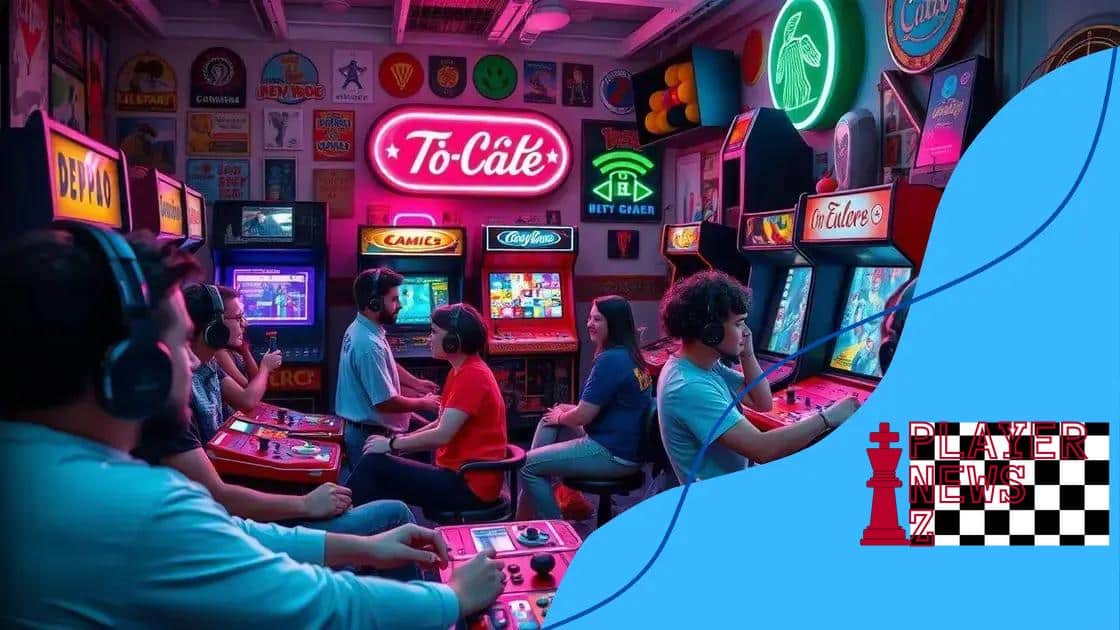The importance of preserving retro gaming history

The importance of preserving retro gaming history lies in maintaining access to classic games, fostering community engagement, and ensuring that the rich cultural heritage of gaming is appreciated by future generations.
The importance of preserving retro gaming history goes beyond mere nostalgia. It shapes our understanding of gaming’s evolution and enriches the experiences of new players. Have you ever wondered how classic games influence today’s designs?
Understanding the roots of retro gaming
Understanding the roots of retro gaming is essential for anyone who loves video games. It allows us to appreciate the culture and innovations that shaped the gaming experience we enjoy today.
In the early days of gaming, limited technology defined what games could be. These limitations sparked creativity in developers, leading to iconic titles that are still loved. Games were simple, yet engaging, relying on storytelling and gameplay mechanics that kept players invested.
Key Elements of Early Gaming
Several key elements formed the foundation of retro gaming, making it distinct:
- Pioneering consoles: Systems like the Atari 2600 and Nintendo Entertainment System introduced the world to home gaming.
- Memorable characters: Characters like Mario and Pac-Man became cultural icons, representing the spirit of their games.
- Innovative gameplay: With limited graphics, developers focused on fun mechanics, creating addictive gameplay experiences.
The community surrounding retro gaming also played a crucial role. Early gaming brought people together. Players shared tips and tricks, often gathered in arcades to compete and enjoy the social aspect of gaming. This sense of community helped shape the landscape, driving both friendship and competition.
Another aspect worth noting is the evolution of game design. As technology improved, so did the complexity of games. However, the influence of early design principles remains evident today. Many modern games draw inspiration from these classic styles, reminding us of gaming’s rich heritage.
The Legacy of Retro Gaming
The legacy of retro gaming can be felt across various genres today. Whether it’s pixel art graphics in indie games or game mechanics that hark back to those simpler times, retro games continue to influence developers. This ongoing impact showcases the importance of preserving these classic games and understanding their roots.
Overall, by exploring the origins of retro gaming, we gain insight into its lasting impact on modern gaming culture. The creativity and community engagement of the past still resonate with players and developers alike, making retro gaming a vital part of our shared history.
Key titles that defined retro gaming
Key titles that defined retro gaming hold a special place in the hearts of players. These games not only shaped the industry but also influenced the direction of future titles. Each game introduced unique mechanics, engaging narratives, and beloved characters.
One important title is Super Mario Bros., which launched on the Nintendo Entertainment System in 1985. This game set standards for platformers, featuring tight controls and innovative level design. Players navigated through vibrant worlds, collecting coins and power-ups, while facing iconic enemies.
Influential Games in Retro History
Aside from Mario, several other games stand out:
- Pac-Man: Introduced maze-chase gameplay and became a pop culture icon.
- The Legend of Zelda: Pioneered open-world exploration in gaming, combining action with puzzle-solving.
- Tetris: Revolutionized puzzle games with simple yet addictive gameplay mechanics.
These key titles have become benchmarks in the gaming community. They not only entertained players but also pushed the limits of what games could achieve at the time. Pac-Man, for example, created a whole new genre of games and influenced level design for years to come.
As technology advanced, titles such as Street Fighter II brought competitive gaming to the forefront. Released in the early ’90s, it popularized fighting games and multiplayer gameplay, making it a staple in arcades around the world. Each of these titles contributed to the rich tapestry of retro gaming.
Even today, the impact of these games remains strong. Many modern games take cues from their gameplay and design, proving that the essence of retro gaming is ever-alive. The legacy of these titles ensures that even newer generations appreciate the classic roots of gaming.
The impact of retro gaming on modern culture

The impact of retro gaming on modern culture is significant and far-reaching. Many elements from classic games can still be seen in today’s gaming landscape, shaping both game design and player experiences.
One major influence is the nostalgia factor. Many gamers who grew up with titles like Super Mario Bros. and Tetris now share these experiences with younger generations. This has brought retro games back into the spotlight, leading to remakes and re-releases that allow new players to enjoy these classics.
Key Contributions of Retro Gaming
Several key aspects highlight the contributions of retro gaming:
- Game Mechanics: Many modern games borrow mechanics from older titles, such as level design and reward systems.
- Art Styles: Retro aesthetics, including pixel art, have gained popularity in indie games, influencing visual storytelling.
- Community Engagement: Online communities continue to thrive around retro games, encouraging collaboration and discussion among fans.
Furthermore, the revival of retro gaming conventions and events brings fans together to celebrate their favorite titles. These gatherings create opportunities for sharing memories and experiences, strengthening the community around gaming.
Another way retro gaming influences modern culture is through its inspiration in popular media. Numerous films and series reference classic games or integrate elements into their storytelling, creating a bridge between past and present. For instance, popular series like Stranger Things showcase characters enjoying arcade games, highlighting the cultural significance of that era.
Additionally, the business models of retro games, such as collectibles and remastered editions, have opened up new avenues for revenue in the gaming industry. Companies recognize the value of these classic titles, and the demand continues to grow.
How to preserve retro games
How to preserve retro games is a crucial topic for gamers and enthusiasts alike. As technology advances, many classic games risk being forgotten or lost entirely. There are several effective methods for ensuring these cherished titles remain accessible for future generations.
One vital step is to keep original hardware in good condition. Storing consoles and cartridges properly can prevent deterioration. Avoid heat and humidity, as they can cause damage. Regular cleaning of cartridges and connectors is also essential to maintain functionality.
Digitization and Emulation
Another way to preserve games is through digitization. This process involves creating digital versions of physical games. There are many benefits to this approach:
- Accessibility: Digital games can be played on modern devices, making them easier to access.
- Backup: Having a digital copy protects against losing the original media.
- Preservation: Digital formats can last longer without the wear and tear of physical media.
Emulators can also play a vital role in preserving retro games. These programs mimic the original hardware, allowing users to play classic titles on modern systems.
Furthermore, communities dedicated to retro gaming often collaborate to share knowledge, resources, and techniques for preserving games. Online forums and social media groups provide tips for maintaining hardware and software, as well as recommendations for reputable preservationists.
Collecting and Archiving
Collecting retro games is another effective way to contribute to their preservation. When searching for classic titles, look for complete sets with original packaging. Items in good condition are valuable not just for play but also for historical significance.
Archiving information about games, such as box art, manuals, and gameplay mechanics, helps preserve their legacy. Websites and databases dedicated to retro gaming can serve as excellent resources for both collectors and casual fans.
Communities and resources for retro gaming enthusiasts
Communities and resources for retro gaming enthusiasts play a critical role in preserving and celebrating the rich history of classic games. These communities offer a space for fans to connect, share knowledge, and promote their love for all things retro.
Online forums are one of the most popular ways for gamers to engage with each other. Sites like Reddit have dedicated threads where users can discuss favorite titles, exchange tips, and even organize gaming events. These platforms foster a sense of belonging among members, allowing them to share their experiences and passion for retro games.
Social Media and Networking
In addition to forums, social media platforms provide valuable resources for retro gaming. Facebook groups and Twitter feeds often serve as hubs for announcements regarding game releases, conventions, and meetups.
- Facebook Groups: Many groups focus on specific consoles or gaming eras, promoting discussions and trading games.
- Instagram: Gamers share images of their collections, setups, and gameplay, sparking inspiration and creativity.
- Twitter Hashtags: Hashtags like #Retrogaming and #VintageGaming help fans find relevant content and engage with others.
Another fantastic resource for enthusiasts is YouTube. Many channels explore retro games, featuring reviews, gameplay walkthroughs, and history lessons about iconic titles. These videos help to bring to life the stories behind beloved games, enhancing appreciation among newer gamers.
Conventions and Events
Participating in retro gaming conventions can be a thrilling experience. Events like TooManyGames or Classic Gaming Expo draw many fans together, featuring vendors, panel discussions, and tournaments. These gatherings encourage discussions about the importance of preserving retro games and allow fans to connect with each other in person.
Ultimately, communities and resources enable retro gaming enthusiasts to keep the spirit of classic gaming alive. Being part of these groups enriches the gaming experience, allowing fans to appreciate the history and impact of their favorite titles while connecting with others who share the same passion.
FAQ – Frequently Asked Questions about Preserving Retro Gaming
Why is preserving retro gaming important?
Preserving retro gaming ensures that classic titles remain accessible for future generations, allowing them to appreciate the history of gaming.
What are some ways to preserve retro games?
You can preserve retro games by keeping original hardware in good condition, digitizing games, using emulators, and archiving important game information.
How can I connect with other retro gaming enthusiasts?
You can join online forums, social media groups, and attend gaming conventions to meet other retro gaming fans and share your interests.
What role do online resources play in retro gaming?
Online resources like YouTube channels, blogs, and dedicated websites provide valuable information, tips, and community support for retro gaming enthusiasts.





